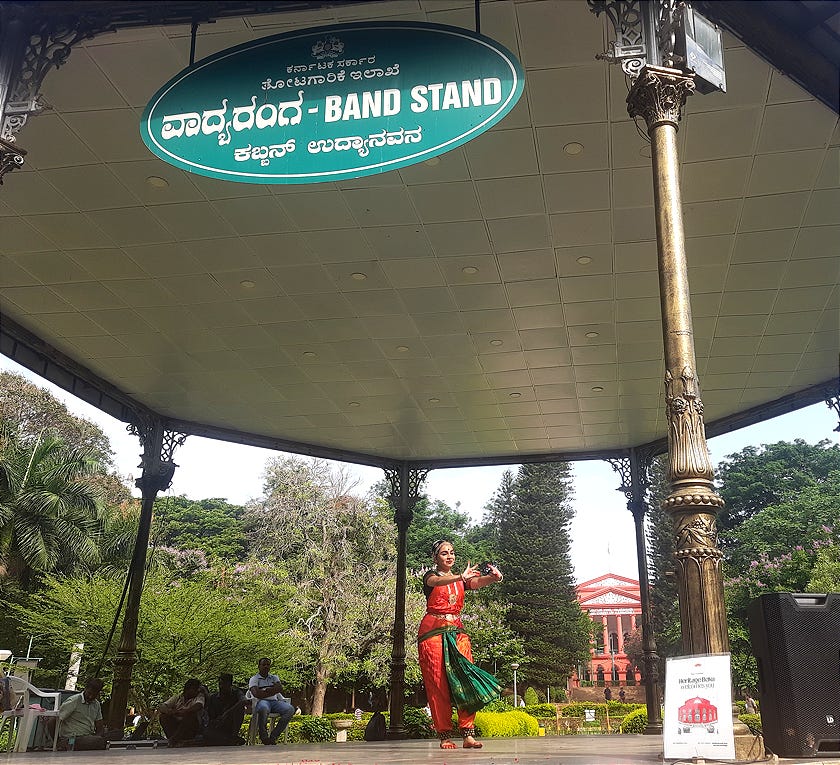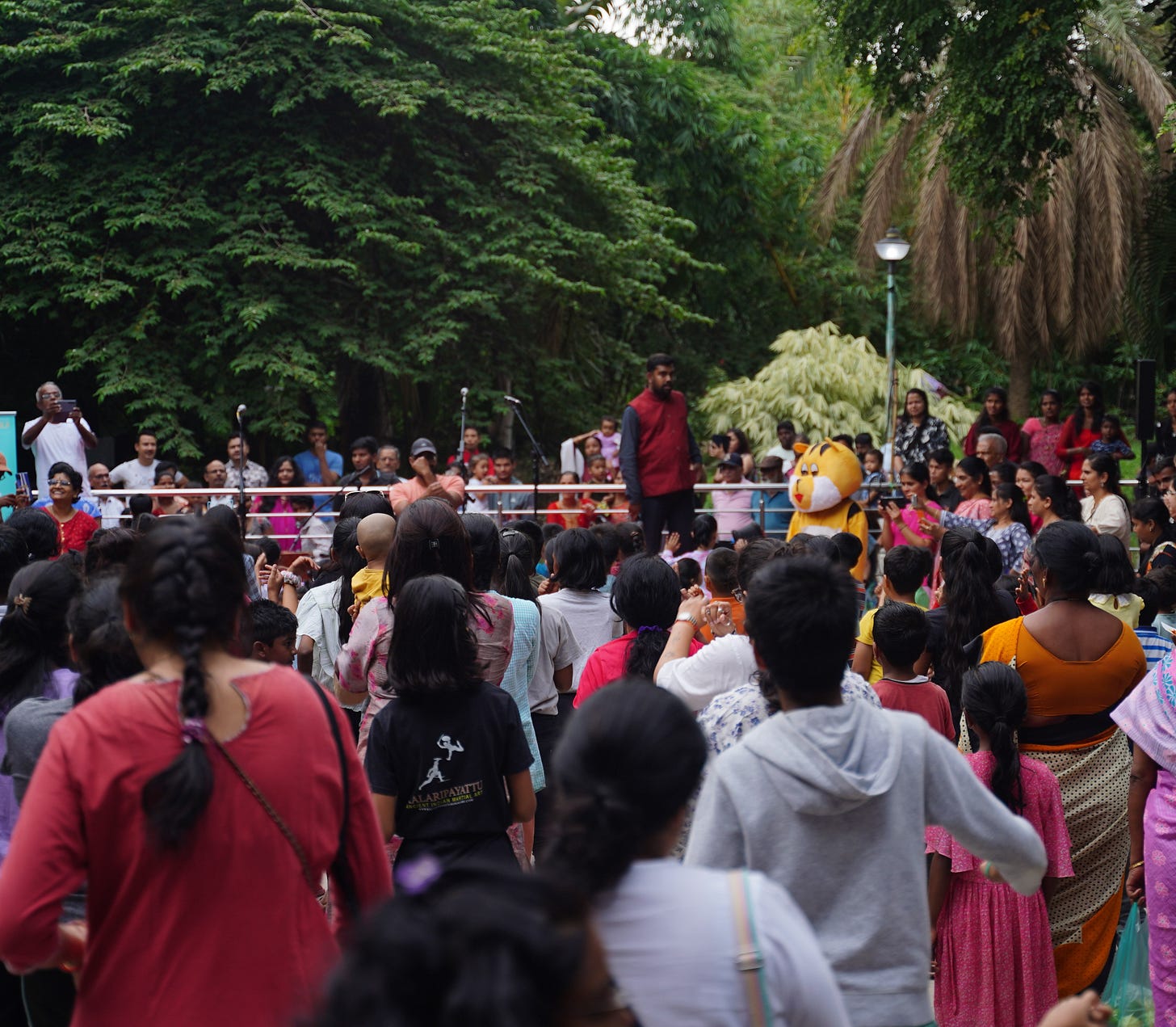BLR Echoes - Environment Day Edition
Blooms, Butterflies, and Bandstand Performances: How Nature and Culture Connect in Bengaluru
Long before Bengaluru was called India’s Silicon Valley, or earned the Tech Capital tag, it was known as the Garden City. The sleepy town was known for its tree-lined avenues, well-planned neighbourhoods, and gardens set up by progressive rulers.
What does culture mean in the tech capital of India? With the burgeoning museum and gallery scene, is it perhaps the increase in spaces to engage with what is traditionally considered arts and culture? Through the pandemic, online spaces, Discord groups, and Whatsapp communities flourished, and now, community groups that convene offline seem to be everywhere in Bengaluru. From silent reading sessions and heritage parks to nature journaling and picnic raves, people are now choosing to meet “the old-fashioned way” – outside and in person. In most cases, some part of the meetups happen outdoors - under lush canopies, in public parks or verdant cafes. And yes, it’s a flex to post “Weekend Vibes” from Cubbon Park, or “Sundaying” at a garden cafe, but it’s not the first time people are sharing their experience around nature in Bengaluru.
Remember when our Instagram feeds turned pink with Tabebuia rosea? Or more recently, when parts of the city were delightfully surprised by the sight of migrating butterflies. Turns out, they do this every year before the onset of the monsoon, and migrate from the Western Ghats to the Eastern Ghats; Bengaluru has always been one of their spots to refuel. It’s just that this year, more people noticed. Some species spotted were Blue Tiger, Dark Blue Tiger, Common Crow, and Tawny Coster. Dr. Shonali Chinniah, Director and Founder of Curioucity Discovery Centre, says:
“Each species feeds on the nectar of a specific (native) flower, and the more we plant these, the more butterflies we might get to see each year.”
She added that we could make this happen by identifying these plants and starting rooftop gardens ourselves! If you missed them this time around, you might be able to catch them later in the year as they make their way back to the west.
It’s no surprise that the city is a part of their migratory trail. We have rich biodiversity hotspots, colourful, blooming trees and green pockets - very intentionally planned. While Hyder Ali and Tipu Sultan can be credited for Lalbagh, and Major General Richard Sankey for Cubbon Park, we can thank German horticulturist Gustav Hermann Krumbeigel for the colourful blooms we're treated to every month in Bengaluru. He was (apparently) inspired by the concept of seasonal blooming from Kalidasa’s poem Ritusamhara, and his legacy now lives strong on our Instagram feeds. Starting with Jacarandas, Trumpet flowers, and the fragrant honge in the spring, to the fiery gulmohars, fluffy raintree blooms and copper pods just before the monsoon arrives - parks, gardens, and residential streets often see run clubs, artist collectives, and wellness enthusiasts meeting, basking, creating, and even performing in parks.
Heritage Beku, a citizen initiative working towards maintaining and preserving Bengaluru's heritage with the Horticultural Department, has been curating cultural programmes at Cubbon Park’s Bandstand. From jazz acts to Bharatnatyam dances, Sunday mornings bring people from all across the city just to experience the joy of live performances at the park.

Curator Ruam Mukherjee adds:
“Many performers recall attending such performances at Lalbagh and Cubbon park when they were younger. We are very lucky to have artists do this pro bono”.
The response to these performances has been overwhelmingly positive, with many people showing up for multiple performances since December. While the return of such programmes may seem like a nostalgic throwback, they’re actually a reflection of how the urban population is craving connection and slowness.
We saw much of the same enthusiasm for celebration in the 2024 edition of Hubba in Your Park, where people of all ages and backgrounds showed up at their neighbourhood parks for various activities, from Zumba to live performances. In a time when screen fatigue is real, these pockets of real-time, real-world connection feel especially vital. Sai Devi Sanjeeviraja, founder of Thicket Tales, shares:
“…now, nature is romanticised. Nature was always a part of culture – from rituals to food habits – it was taken for granted! The newer generation is picking it up much more intentionally. Not as a part of their lifestyle and habits, but as a way to pause.”
Institutions in the city are taking note and leveraging the power of immersive experiences and storytelling to encourage deeper engagement with nature. From butterfly and firefly walks to mushroom foraging and food tasting sessions spotlighting local produce, there’s a broader cultural shift taking place, where knowing more translates to caring more. Perfect timing too, since there’s a real need to identify, save, and increase the city’s green cover. This is why, on World Environment Day, we launched Hasiru Bengaluru. Under an MoU with the BBMP, the goal is to transform unused and underutilised public land into high-density microforests. We’re excited to be working with partners like United Way Bengaluru, Bangalore Political Action Committee (BPAC), Rainmatter Foundation, and others and create a collective devoted to nurturing and expanding urban green spaces.
In other news, we just dropped the 9th episode of From Code To Culture with ISRO’s former chairman — Dr. S. Somanath! Our hosts Malini Goyal and Prashanth Prakash explore the story of India's space programme, and some of the key milestones that shaped its success. Dr. Somanath takes us through his journey at ISRO – his humble beginnings, projects he’s most proud of, and shares candid reflections on his challenges. We also dive deep into major projects like Chandrayaan, Mars Missions, the strategic Space Vision 2047, and get insights into India’s future in the space tech industry. We won’t tell you any more - watch it to find out!
That’s a wrap for this edition. As always, we’d love to hear from you!
Until next time!




